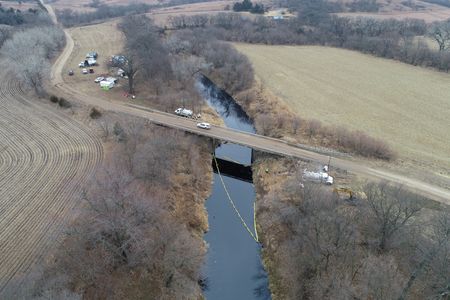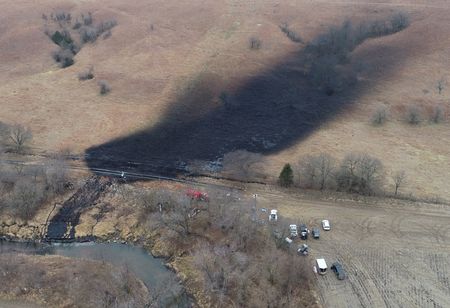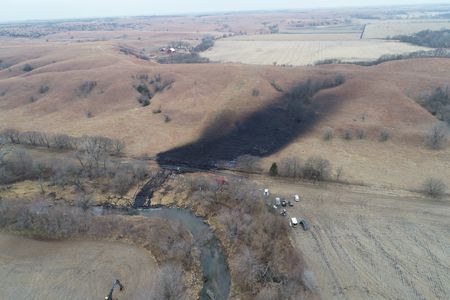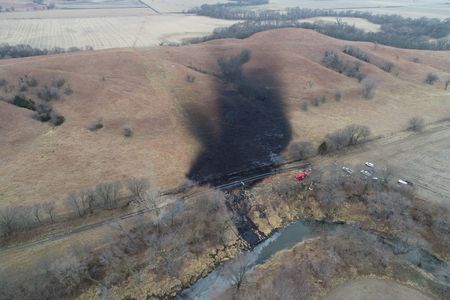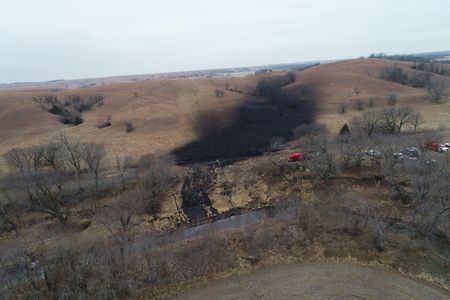By Erwin Seba and Nia Williams
WASHINGTON, Kansas (Reuters) -Emergency crews on Friday were preparing to labor through the weekend to clean up the largest U.S. crude oil spill in nearly a decade, with workers descending on this farming community from as far away as Mississippi.
A heavy odor of oil hung in the air, according to a Reuters witness, as tractor trailers ferried generators, lighting and ground mats to a muddy site. Federal investigators were at the scene trying to help determine what caused a leak of some 14,000 barrels of oil from Western Canada, an official said.
Pipeline operator TC Energy on Friday said it was evaluating plans to restart the line, which carries 622,000 barrels of oil per day to U.S. refineries and export hubs. It did not provide details of the breach or when a restart could begin.
The outage could affect oil inventories at the Cushing, Oklahoma, storage hub and cut crude supplies to refining centers in the Central U.S. and Gulf Coast, analysts said.
“We’re beginning to get a better sense of the clean up efforts that will need to be undertaken in the longer-term,” said Kellen Ashford, spokesperson for the EPA Region 7, which includes Kansas.
Environmental specialists labored in near freezing temperatures and crews set up equipment to allow operations to continue for days.
TC Energy aims to restart on Saturday a pipeline segment that sends oil to Illinois, and another portion that brings oil to Cushing on Dec. 20, Bloomberg News reported, citing sources. Reuters has not verified those details.
This is the third spill of several thousand barrels of crude on the pipeline since it opened in 2010. A previous Keystone spill had caused the pipeline to remain shut for about two weeks.
TC Energy remained on site with around 100 workers leading the clean-up and containment efforts, and the EPA was providing oversight and monitoring, Ashford said. TC is responsible for determining the cause of the leak.
U.S. regulator Pipeline and Hazardous Materials Administration said the company shut the pipeline seven minutes after receiving a leak detection alarm. The affected segment, 36 inches (91 cm) in diameter, was Keystone’s Phase 2 extension to Cushing built in 2011.
Washington County, a rural area of about 5,500 people, is about 200 miles (320 km) northwest of Kansas City.
The spill has not threatened the local water supply or forced local residents to evacuate, Washington County Emergency Management Coordinator Randy Hubbard told Reuters. Workers quickly set up a containment area to restrict oil that had spilled into a creek from flowing downstream.
“There is no human consumption drinking water that would come out of this,” Hubbard said.
Livestock producers in the area have been notified and have taken their own corrective measure to protect their animals, he added.
The EPA is the main federal agency that oversees inland oil spills. If the EPA finds TC Energy liable for the spill, the company would be responsible for the cost of cleanup and repairing any harm to the environment, as well as potential civil and criminal penalties.
Pipeline operators are typically held accountable for breaches by the EPA through the Clean Water Act (CWA) and the related Oil Pollution Act, among others, according to Zygmunt Plater, an environmental law professor at Boston College Law School.
Those federal acts restrict the discharge of pollutants such as oil into waterways and hold pipeline operators responsible for the costs associated with containment, cleanup and damages from spills.
CRUDE BOTTLENECK
A lengthy shutdown of the pipeline could also lead to Canadian crude getting bottlenecked in Alberta, and drive prices at the Hardisty storage hub lower, although price reaction on Friday was muted.
Western Canada Select (WCS), the benchmark Canadian heavy grade, for December delivery last traded at a discount of $27.70 per barrel to the U.S. crude futures benchmark, according to a Calgary-based broker. On Thursday, December WCS traded as low as $33.50 under U.S. crude, before settling at around a $28.45 discount.
PHMSA has to approve the restart of the line. Even once the pipeline starts operating again, the affected area will have to flow at reduced rates pending PHMSA approval.
“The real impact could come if Keystone faces any pressure restrictions from PHMSA, even after the pipeline is allowed to resume operations,” said Ryan Saxton, head of oil data at Wood Mackenzie.
(Reporting by Erwin Seba in Washington, Kansas; Additional reporting by Arathy Somasekhar, Rod Nickel, Stephanie Kelly and Clark Mindock; Editing by Marguerita Choy and Daniel Wallis)

